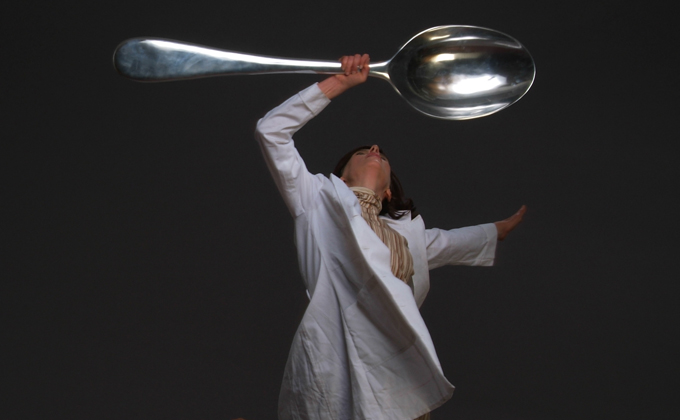
Michelle Ellsworth in Preparation for the Obsolescence of the Y Chromosome
Performance as Empathy: Fusebox Festival 2015
How can a festival be used as a tool? “Is it possible to tap into the collective intelligence of a festival?” Ron Berry, founder and artistic director of Austin’s Fusebox Festival, asked these questions —important ones in a town crazy with festivals — during an April 2d talk about Fusebox, over Texas-shaped waffles in the backyard of Co-Lab Projects’ East Austin gallery.
For the 11 years of Fusebox’s existence, Berry, who has been part of Austin’s theatre community since the mid-90s, has curated staggering lineups of national and international experimental and cross-genre works alongside local ones. The impresario who can be identified by the trucker hat, close-cut beard and glasses encourages idea-sharing through happy hours, blog posts, artist talks and the “waffle chat.” Since 2014, the whole thing has been free to attend.
The work that Fusebox presents — dance, performance, live film, experimental theatre, installation, literary text messaging — isn’t the kind of art that can go up for auction or be acquired. It’s heavy on the empathy in degrees kinetic, physiological, emotional. That opens the transom for talk about other things lacking a price: social justice, civil rights and community-building.
This year, the festival included an experiment called ThinkEAST, a pop-up “living charrette” where artists and festival-goers were encouraged to join the conversation about developing a piece of land, a former fuel tank farm, cleaned up after a community uprising in the 1990s. The tank farm sits among among Hispanic and African American neighborhoods on Austin’s East Side. Time will tell whether ThinkEAST added anything of value to the conversations already in progress among the city, residents of surrounding neighborhoods, artists and developers, but time spent at existing Eastside theaters and galleries (many sprouted within the last couple of years) reveals, on a macro level, two different communities — artists and the neighborhood’s historic residents living parallel lives, rather than ones joined together.
Nevertheless, it remains important, from both an artistic and a social perspective, that Fusebox continues to present performance works, like Michelle Ellsworth’s one-woman show, Preparation for the Obsolescence of the Y Chromosome.
Ellsworth, on the faculty at CU–Boulder, was co-presented in Austin for the second year in a row by Fusebox and Women and Their Work gallery. She is parts comedian, dance-choreographer and ethnographer. In Preparation, she riffed on her “performative website” that proposes solutions, inventions, and motivational videos in response to the theory that the Y chromosome might have been shrinking, a theory refuted during the development of the piece. “Not dicking around with the science is actually important to me,” she said in an interview.
This shift in scientific theorizing, combined with the recent death of her father, are responsible for the work’s arc: the pseudo-conference presentation, which she rushes through like a flight attendant in front of a firing squad of scientists, devolves into confessional “non-science.” In the end, finding her motivational videos lacking, she attempts to record a new one focused on real grief.
Records and memory were also explored in A Quartet, a dance by Seattle-based Heather Kravas, with repetition, synchronicity, and patterns. Standing behind one another in a train, the dancers made regimented movements, sometimes accompanied by a score of live guitar, vocals, and electronic sounds, before shedding their street clothes and using their bodies to form letters on the floor. (Though I couldn’t see all the letters from my second-row vantage point, other reviews say they spelled “society”). Next, they donned ballet attire, and while two of them traversed the narrow rectangle with endless tendus, sous-sous, and turns, the other two paced, swinging one arm military-like, around them and behind the audience.
When they reappeared in street clothes, they had bells in their hands and around their wrists. What remains with you? this addition seemed to ask, after training your body and mind? They then recited a grocery list while performing a box step, speeding up to breakneck. This list got inside our own heads. Waiting to cross the street after the performance, a fellow audience member and I repeated “milk, bread, coffee . . .” Later, when I forgot the sequence, the effect on me was distressing.
But Otro Teatro, by luciana achugar, a Brooklyn-based choreographer from Uruguay, was the most revolutionary of the shows I attended. The piece, labeled “a solo performance,” began with achugar nude except for a shroud of thick black fabric, in near-darkness. The theater was lit upward, which gave the impression that there was no ceiling, only blackness. As achugar moaned, rocked, swirled, and chanted, exerting herself into an extreme state, she could have been the last person on Earth, or perhaps everyone on Earth, as seen from a great, great distance.
In program notes, achugar credits inspiration for the piece to the “theatre collages,” depicting ruined theatres, of Argentinean artist Guillermo Kuitca. For the dancer, the theatre and body are sacred, and in Otro Teatro, both appeared in a state of extreme pressure. Around the time when achugar discarded the shroud to reveal her nude body, streaked with red tape, it became clear that some members of the audience were playing along, moaning, tapping, and shifting in their chairs. The woman seated behind me was barefoot. Before the end of the show, she would be splayed across the stairs, yelling full throttle, as if in active labor.
The work ended with an onstage party, which the audience members were invited to join. This shallow denouement proved that we’d survived the storm: the roof had blown off, but we’d come through just fine.
In his waffle chat, Berry had mentioned that he wouldn’t be surprised if people walked out on Otro Teatro.
It’s testament to the festival audience—and to Berry’s aspirations to use the festival as a social tool—that, during the show I attended, most of the people who left the theater returned just a few minutes later, drinks in hand.
